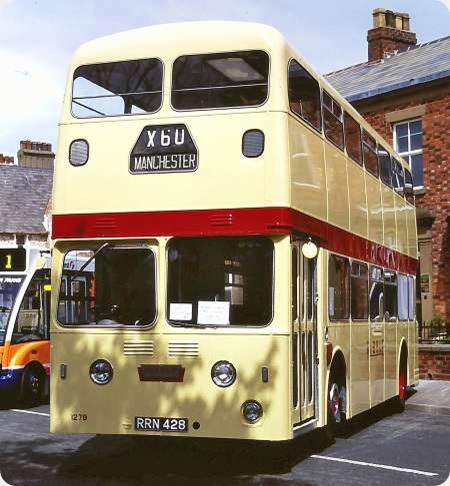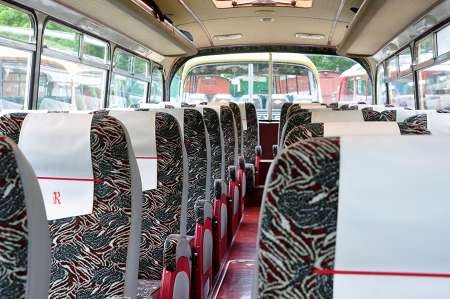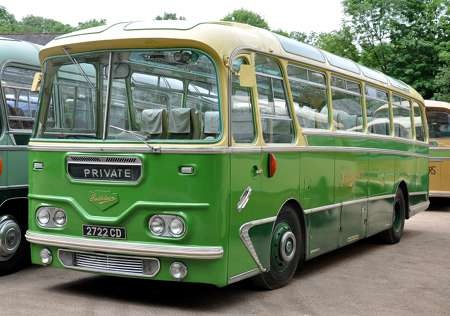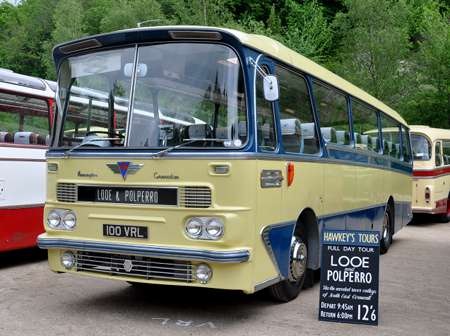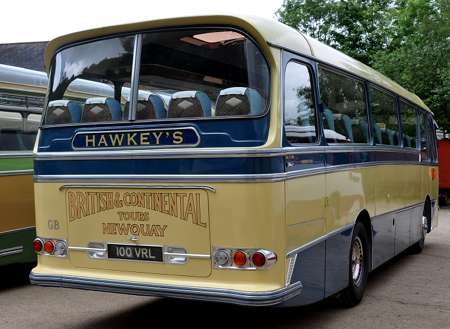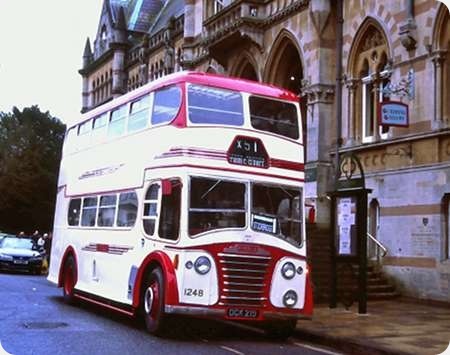Ribble – Leyland Atlantean – RRN 428 – 1279
Ribble Motor Services
1962
Leyland Atlantean PDR1/1
Weymann CH39/20F
Here are two views of RRN 428, one of Ribble’s ‘second generation’ fleet of "White Ladies". She is a Leyland Atlantean PDR1/1 with Weymann CH59F bodywork – more than on the "Gay Hostess" fleet because there is no toilet, but less than the normal bus seating because the rear seats downstairs are replaced by a luggage area. Note the white opaque windows. She’s in Fleetwood for the Tram Sunday event on 20 July 2003.
Photograph and Copy contributed by Pete Davies
16/08/16 – 07:27
1279 is owned by the Ribble Vehicle Preservation Trust. It is currently undergoing a major overhaul at the Freckleton Base.
Don McKeown
18/08/16 – 06:51
These were used regularly on the X60 from Manchester to Blackpool, and if they left Lower Mosley St with a full "through" load would sometimes go "off route" between Bolton and Preston, using the A675 through Belmont – Ribble actually held a licence to use this stretch of road between Bolton and Preston/Blackpool, although timetabled journeys used the service number X100. The A675 is a lot more curvy and undulating than the official route and the terrain seemed to have an unsettling effect on the White Ladies’ suspension. I’ve never suffered from travel sickness (even as a child), but the ride quality made me queasy and you could guarantee that at least one person would throw up before Preston. The drivers on the other hand seemed to enjoy the challenge!
Neville Mercer
18/08/16 – 10:02
I particularly remember these fine vehicles working the X43 Manchester- Skipton, and can not recall any instances of sickness. However in December 1962 I travelled to Grasmere on the X40 from Manchester. This was usually a "Gay Hostess" working, but this particular day a "White Lady" turned up. All went well until Lake Windermere was reached. At one point there was a highish stone wall and all that was visible on the nearside was water. The roll of the coach plus the water produced a sea-sickness effect with devastating results. The top deck was full of teenage boys who had been filling there faces with all manner of food since leaving Manchester. The rest as they say is history…
Andrew Gosling
18/08/16 – 13:58
I remember at Lancaster a driver coming upstairs and asking us to move downstairs due to the high percentage of queasiness from there to Keswick!/em>
Roger Burdett
19/08/16 – 06:34
Thanks for your thoughts, folks! I have some very vague memories of an article in the old MECCANO MAGAZINE, early 1960’s about a group of Leyland apprentices who had built and Atlantean chassis out of rejects. They called it the Royal Mouse. If memory serves correctly, first was thrown out, everything else went down and a new top was fitted.
I’m only glad that, with the Gay Hostess and White Lady air suspension, the Royal Mouse never went into production!
I only travelled upstairs on a Gay Hostess once, M6 between Birmingham and Lancaster in my student days. Usually, I was either downstairs or on a single decker.
Pete Davies
19/08/16 – 06:35
Did the "Gay Hostess" vehicles have a better ride than these vehicles – less queasiness?
Chris Hebbron
19/08/16 – 08:12
The "Gay Hostess" seemed to have a better ride, but a lot seems to depend on road surface and camber. The Keswick run was the only time I experienced problems on a "White Lady". My return journey from Grasmere (see earlier comment) was on a "Gay Hostess" and was a good deal smoother than the "White Lady". The weight distribution of two models could well have been very different. Expert needed! Before political correctness was invented, I was told by a male East Yorkshire driver that they hated having a clippie on a Bridgemaster, as any "clearing up" had to be done by the driver!
Andrew Gosling
19/08/16 – 14:08
Thx Andrew.I suppose that the ride on a double-decker much depends on the balance of folk upstairs compared with downstairs, to some extent, not exactly top heavy but you know what I mean. Southdown 700 was, apparently, truly awful, these later vehicles better. One wonders what modern ones are like. Megabus and others run them with everyone upstairs, apart from a handful, usually disabled folk, downstairs, plus vending machines and toilets. Maybe air suspension gives better control.
Chris Hebbron
20/08/16 – 05:54
Thx Andrew.I suppose that the ride on a double-decker much depends on the balance of folk upstairs compared with downstairs, to some extent, not exactly top heavy but you know what I mean. Southdown 700 was, apparently, truly awful, these later vehicles better. One wonders what modern ones are like. Megabus and others run them with everyone upstairs, apart from a handful, usually disabled folk, downstairs, plus vending machines and toilets. Maybe air suspension gives better control.
Chris Hebbron
20/08/16 – 05:54
Some of these modern vehicles frighten me with their (notice correct grammar today!) vast size and what could happen in an accident. The only modernish large coaches that I have travelled on were the Central Liners . One was an MCW Metroliner, the other was possibly a Neoplan but I am not sure.They produced quite a comfortable ride. They were full of charming teenage children, which must be high risk w.r.t. travel sickness. In fact no problems were experienced! There has been much criticism of Lowbridge Atlanteans, but I have been on Ribble vehicles to Rossendale (X13/23) and found travel in the raised section very pleasant. The same can be said of PMT vehicles on the Stoke- Stafford run. These were in the 60s when roads were maintained to a much higher level. The amount of rattles on modern vehicles seems very great, this may be road surface, poor design or both.
Andrew Gosling
20/08/16 – 05:55
I’ve travelled some distances on Neoplan Skyliners (as once used on Motorway Expresses) and they just seem to have sophisticated suspensions. Behind the two rear axles was a huge luggage compartment and the engine, so the small lower saloon didn’t provide much ballast. On French D roads with steep cambers they did lurch a bit, but not often and that more seemed the rear wheels/ suspension soaking this up rather than the whole vehicle. What were the Standerwick Bristols like?
Joe
20/08/16 – 10:22
Joe, re Standerwick Bristols, I can only comment on what I have read which contains much unfavourable material. The engine position must have presented stability problems. A local (now defunct) bus company bought one second hand. I never saw it other than in their yard!
Andrew Gosling
20/08/16 – 11:06
To answer Joe’s question, I only ever saw them parked at Fleetwood (in NBC white = YUK!), never moving, and I never rode on them. I seem to recall that one fell over in some way, but the mitigating circumstance was that it was hit by a marauding lorry. They were VRL, I think, not the usual VRT, and Reading had some of that layout. Perhaps one or more of our members from that area can enlighten us, remembering of course that the Reading ones were buses not double deck coaches
Pete Davies
20/08/16 – 17:45
Correction! I now realise that the Reading ones are listed as VRT/LL rather than VRL. Sorry!
Pete Davies
23/08/16 – 06:03
The Standerwick VRL M1 accident near Luton on a wet road surface on 26 July 1974 arose as a result of an immediately previous collision involving a jacknifed lorry that left a lamp standard leaning across the carriageway. The driver was placed in an impossible situation. In attempting to avoid the obstructions, the VRL turned over, killing three and injuring 30 others. The hysterical tabloid coverage distorted the facts of the sad event, and attention hungry politicians then jumped on the bandwagon by threatening to ban double deck coaches from the outside lane of motorways.
Roger Cox
23/08/16 – 10:15
Thanks, Roger.
Pete Davies
30/08/16 – 15:08
Out of interest, has anyone got any colour pictures of Ribble 2173, in Ribble timesaver colours.
Stephen Hamer
31/08/16 – 10:13
Stephen, 2173, no. 2174 in the ‘Venetian blind’ stripes, yes, if it’s of any use to you. (Inside Devonshire Road garage)
Pete Davies
18/10/16 – 07:48
Thanks Pete, it would be a great help with re painting 2173. At the moment it is in the old Lancashire United blue and cream. Many thanks.
Stephen Hamer
20/10/16 – 15:47
Many thanks Pete, the photo of 2174 will help a great deal. There are not a lot of photos of 2173. Thanks again.
Stephen Hamer
Quick links to the - Comments Page - Contact Page - Home Page

